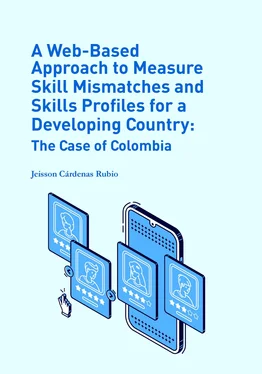*Unemployment rates are graphed on the right-hand scale.
However, in Colombia, it took a relatively long period (15 years) to decrease unemployment and informality rates to 5.8 and 2.9 percentages points, respectively. Additionally, informality and unemployment trends changed in 2017 and 2018, when the unemployment rate increased by 0.2 and 0.3 percentage points, respectively, and informality rates stagnated around 47%. Although these rates have declined in recent decades, Colombia’s unemployment and informality rates are above the world average, and even above the Latin American average (World Bank, n.d.). In particular, in 2015, Colombia was the second economy in the Latin American region with the highest unemployment rate (only surpassed by Brazil), and its informality rate was around 1.4 percentage points higher than the regional average (ILO 2016b). However, informality and unemployment do not affect all workers equally. Table 3.1shows the general characteristics of the Colombian workforce between 2016 and 2018.
Table 3.1. Characteristics of the Colombian workforce
| Variables |
Formal workers |
Informal workers |
Unemployed |
| % General characteristics |
| Male |
56.7% |
53.9% |
44.3% |
| Less than 29 years old |
30.5% |
23.3% |
49.1% |
| Between 29 and 58 years old |
64.9% |
62.3% |
45.7% |
| More than 58 years old |
4.6% |
14.4% |
5.2% |
| % Educational level |
| Less than high school |
7.0% |
29.1% |
14.5% |
| High school |
42.5% |
53.4% |
53.3% |
| Lower and higher vocational education |
21.3% |
11.3% |
18.4% |
| Graduate |
19.5% |
5.2% |
11.4% |
| Postgraduate |
9.8% |
1.0% |
2.4% |
| Labour market outcomes |
| Mean wage (Colombian pesos) |
1,511,246 |
910,508 |
- |
| Mean hours worked per week |
47.2 |
43.8 |
- |
| Underemployment |
31.7% |
35.6% |
- |
| Agriculture, hunting, and forestry |
2.5% |
5.2% |
3.4% |
| Mining and quarrying |
1.0% |
0.2% |
1.0% |
| Manufacturing |
16.0% |
11.0% |
11.3% |
| Electricity, gas, and water supply |
1.3% |
0.0% |
0.5% |
| Construction |
5.3% |
8.4% |
11.3% |
| Wholesale and retail trade, hotels, and restaurants |
18.9% |
42.1% |
30.0% |
| Transport, storage, and communications |
6.7% |
11.5% |
6.8% |
| Financial intermediation |
3.3% |
0.4% |
1.6% |
| Real estate, renting, and business activities |
13.1% |
6.7% |
9.2% |
| Community, social, and personal service activities |
31.9% |
14.5% |
24.9% |
| Duration of unemployment (weeks) |
- |
- |
20.2 |
Source: Author’s calculations based on GEIH information.
According to the first column, 56.7% of formal workers are male, while the second column indicates that 53.9% of informal workers are male. This result is because in the Colombian labour market more men are working than women. However, the presence of women in the informal market is 2.8 percentage points higher than women in the formal market. Moreover, the third column shows that 55.7% of unemployed individuals are women. These results suggest that unemployment and informality issues are comparatively higher for women than for men.
According to the age distribution of all workers (males and females combined), 2930.5% of formal workers were less than 29 years old, compared to 23.3% of informal workers. In contrast, only 4.6% of formal workers were over the age of 58 years, compared to 14.4% of informal workers. However, almost half (49.1%) of the Colombian unemployed population were less than 29 years old, followed by people between 29 and 58 years old (45.7%), and over 58 years old (5.2%). Consequently, older Colombian workers tend to be more exposed to informality, while young workers are more likely to experience unemployment issues.
The educational distribution 30shows that the higher the level of education (lower and higher vocational education, graduate or postgraduate), the higher the proportion of formal workers when compared to the proportion of informal workers. Moreover, more than half of the unemployed individuals in Colombia have just a high school certificate. In fact, most formal and informal workers and those who are unemployed only have a high school certificate (42.5%, 53.4%, and 53.3%, respectively).
The monthly average wage of a formal worker is around 1,511,246 pesos (around £377), while the average salary of an informal worker is about 910,508 pesos (around £227). In accordance with Mondragón-Vélez, Peña, and Wills (2010), a formal worker earns 1.6 times more than an informal worker. In contrast, an informally employed person works 3.4 hours less per week than a formal worker. More than one-third of workers are underemployed because of the underutilisation of their skills (skill surpluses; see Chapter 2). However, this percentage is higher for informal workers.
Around 31.9% of formal workers are employed in companies related to community, social, and personal service activities, followed by the wholesale and retail trade, hotels, and restaurants (18.9%), as well as manufacturing (16.0%). In contrast, most informal workers are in the wholesale and retail trade, hotels and restaurants sector (42.1%), followed by community, social, and personal service activities (14.5%), as well as transport, storage, and communications (11.5%). Additionally, most unemployed individuals used to work in the wholesale and retail trade, hotels and restaurants sector (30.0%), community, social, and personal service activities (24.9%), construction (11.3%), and manufacturing (11.3%). Therefore, the sectors that concentrate most of the informal and unemployed people are the wholesale and retail trade, hotels and restaurants sector, and companies related to community, social, and personal service activities. The last row of Table 3.1shows that the average duration of unemployment was around 4.7 months (20.2 weeks); this indicates that the duration of unemployment in Colombia is above average compared to the average of the OECD countries, which was 3.6 months between 2016 and 2017 (UK Data Service, n.d.).
The results from Figure 3.1, Figure 3.2, and Table 3.1confirm that informality is a widespread and persistent problem in the Colombian economy. However, these outcomes can be explained by two different phenomena with different implications for public policy and economic research. As pointed out in Chapter 2, informality might be explained by “exclusion” and “exit” processes. The first term, “exclusion,” refers to the situation where there are labour market segmentation and barriers that prevent informal workers from taking formal jobs (with state-mandated benefits). The second term, “exit,” occurs when workers and firms decide to stay outside of formality given that the cost of being formal exceeds the benefits of belonging to this sector.
Even though both views (exclusion and exit) are important in Colombia, evidence suggests that exclusion mechanisms are more relevant for the Colombian context. According to Perry et al. (2007), the fraction of informal and independent workers who would rather be formal employees is around 40% in Argentina, 59% in Colombia, and 25% in Bolivia and the Dominican Republic. When informal self-employed workers were asked about their motivations/reasons for being in their current job as an independent worker (such as autonomy, flexible hours, could not find a salaried job, higher wages), their main response to why working as informal and self-employed was that they could not find a salaried job: 59% in Argentina and 55% in Colombia gave this response (Perry et al. 2007, p. 66). Additionally, the authors found similar results for informal salaried workers; thus, difficulties in finding a formal salaried job constitute a much higher fraction of the reported reasons for being in informal salaried jobs than other possible responses.
Читать дальше












